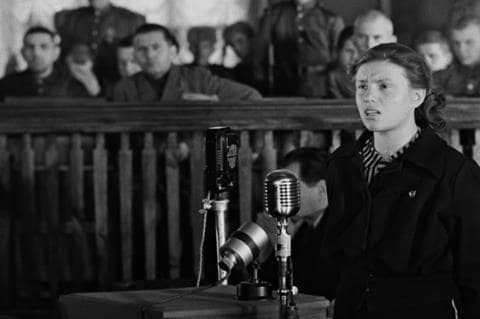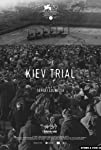Eye For Film >> Movies >> The Kiev Trial (2022) Film Review
The Kiev Trial
Reviewed by: Jennie Kermode

In January 1946, nine months ahead of the Nuremberg trials, some of the foremost legal practitioners in the Soviet Union assembled in Kiev for the trial of 15 German Nazis accused of committing war crimes. They had multiple aims: to secure due process (discouraging vigilante attacks which were making it hard to restore peace in some areas), to demonstrate that acts committed in war could be scrutinised just as intensely as crimes in peacetime, to hold those particular individuals to account and to give the survivors a sense of closure. They also sought to tease out the truth of events in order to contribute to an accurate history and begin the process of trying to understand how it all happened, in the hope that it might be possible to prevent it from happening again.
Director Sergei Loznitsa came across archive footage of this trial when researching his 2021 documentary Babi Yar. Context, and immediately knew that he had something special. He set about editing it down so as to tell the story of the trial from start to finish, and the result is a powerful piece of work with its own contribution to make to history. The footage may have suffered from the ravages of time and may not present the best visual quality, but even so, it is impossible to look at the faces of the witnesses speaking here and not see their pain, not know that what they are speaking is the truth.
The obvious point of comparison here is the Eichmann trial, but Eichmann was an actual psychopath who showed very little emotion on the stand. All of the senior Nazis to stand trial were to some extent prepared, possessed of ideological convictions which made their actions and their denials make sense to them. Most of those tried in Kiev were far less sophisticated, and as a consequence this film is much more revealing when it comes to the psychology behind their brutal behaviour.
One of them, who looks barely 20, talks about burning homes and rounding up villagers so that they could be sent to Germany, going on to explain how he had some of them summarily shot when they resisted. He doesn’t look ashamed but he does look intimidated, avoiding eye contact whenever he can. This, combined with his high pitched voice and slight plumpness even after time spent in a Soviet prison, makes one wonder if he was bullied at school, if he went straight from that to trying to prove himself by doing horrendous things to innocent people. He seems aware that his excuses don’t make sense even as he utters them. His own words are enough to make redemption seem impossible, yet his presence points up another horror, rarely discussed: that senior Nazis knew they were doing this kind of damage to tens of thousands of young soldiers, destroying their own people as well as others.
Another, only slightly older looking man talks about people being forced to undress as he was herding them along, and about children being pulled from their mothers’ arms to be shot. He says that the firing squads were mostly drunk. He was there, participating, yet he speaks as if he were merely an observer. Only on a couple oif very specific points does he deny his own involvement. It’s as if, rather than trying to hide what he did from the court, he is still trying to hide it from himself, unable to reckon with his own nature.
Over the decades we have heard the phrase ‘just following orders’ innumerable times. It is usually interpreted as an excuse, but watching this, it becomes clear that that really is as far as some of these soldiers thought – perhaps consciously choosing not to let their minds wander any further. There’s a different kind of monstrousness in the failure to question. Speaking relatively little, allowing the defendants to give clear reports as they have been trained to do, the prosecutors gently tease apart the difference between following orders and exceeding them, demonstrating that not only did these men fail in their moral responsibility to resist, but that most of them exceeded their orders in terms of the brutality which they used. This is a process which some of them seem to find confusing, as if, at some point, they simply lost their awareness of the distinction, perhaps at the same time as they lost their awareness of the humanity of those they persecuted.
The Nazi testimonies are delivered in German, then translated into Russian, with English subtitles appearing a fraction of a second later. If you know even a little of each of these languages, or even if you just pay close attention to tone, the result is a series of horrors emerging bit by bit, gradually pushing their way into full consciousness. Loznitsa could have cut out the repetitions, but the film is much more powerful for their presence.
Survivors also address the court. A teenage girl talks about the killing of partisans and teachers. A young woman recalls how some mothers went mad after their children were taken; how they later learned that some of their worst fears had come true, and that the children had been very slowly bled to death in a camp. Another recounts an extraordinary story of survival which will leave viewers in awe, not just at her physical courage but at the willpower and strength of character which it took for her to survive. She stands there in the courtroom like a superhero, like everything the Nazis fantasised that they might themselves be, but fell desperately short of. For all her pain, she blazes with unquenchable light.
There is also a moment, about halfway through, when a priest who has been invited to talk about the desecration of icons in his church reflects on happier times, telling a ribald story about events at a wedding there before the Revolution, and the whole courtroom breaks into laughter. Being a man used to working crowds, he must have known what he was doing, as Loznitsa does in including this scene. By providing this desperately needed reprieve, he gives those present the mental space to take in the full horror of what they have been hearing. It’s a point of contrast which reminds us what life ought to be like and puts everything else into perspective.
The film’s only other laugh comes at the end when, in his closing statement, a former commandant protests that he has only just learned about these crimes against the Ukrainian people. It is the sound of an illusion finally shattered, the sound of a shift of power. Nobody believes him anymore.
What follows is another uncomfortable but necessary scene: footage of the court’s sentence being carried out in Kaliinin Square (now Independence Square) in the centre of Kiev. It’s notably less ugly than some of its Western equivalents, the matter resolved with the precision of which the Soviets were then proud, so that only one man continues to kick. An enormous crowd looks on. For them, this is the moment when it is over, a horror to end the horrors, a chance for life to begin again.
Loznitsa had finished his work on this film when the Russians invaded Ukraine. There is an extra layer of horror in listening to these reports of war crimes as people in the same regions suffer such violence again. As this film screened at the Venice Film Festival, Loznitsa said that he hoped they shall not have to wait long for justice.
Reviewed on: 08 Sep 2022















